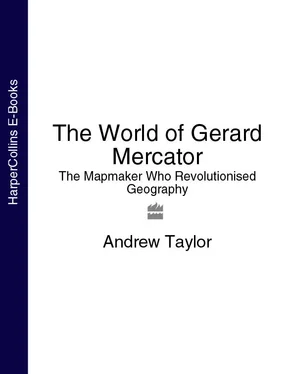The Mappa di Bedolina in Italy.
Centuries later, merchants and travelers who were pushing farther and farther afield in the search for new markets brought back garbled reports of the mighty Rivers Don and Nile running south out of Asia and north out of Africa to form a T -shape with the well-traveled waters of the Mediterranean. The waters of the ocean were then thought to surround the world in a gigantic O , leading to the creation of the so-called T-O maps, which represented for ancient Greek, Roman, and even Arab seamen an agreed image of the outline of the world.
A T-O map from Etymologiarum by Isidore of Seville
British Library, London, Rare Books and Maps Collections
THAT WAS THE WORLDVIEW Claudius Ptolemy inherited as he worked in the great library of Alexandria around the middle of the second century AD. His name appropriately linked the Greek-Egyptian Ptolemy with the Latin Claudius, for Alexandria was a cosmopolitan place, more than five hundred miles from Greece, under Roman rule, and yet at the heart of Greek civilization. The city, with its port and its great lighthouse, was a triumphal expression of Greek civilization and Roman power. Like Antwerp in Mercator’s day, it was one of the world’s great cultural and commercial crossroads, with mineral ores and spices ferried down the Nile from the depths of Africa and along an elaborate network of canals, then traded along the waterfront with the day-to-day cargoes that had been brought into harbor from the busy eastern Mediterranean. Sailors and merchants brought with them tales of distant lands like Taprobane, half-digested stories that might conceal a thin vein of truth for scholars trying to extend their grasp of the unknown world. Busy ports have always been the mines of geographers; travelers’ gossip was the unsmelted ore of exploration for Ptolemy, as it was to be for Mercator.
The merchants brought wealth to Alexandria as well. In the days of its greatness, the story went, the buildings contained so much glistening marble that a tailor could thread his needle by the reflected light of the Moon. The library where Ptolemy worked, with its collection of some seven hundred thousand manuscripts in Hebrew, Greek, and Egyptian, was one of the most obvious expressions of that wealth. Just as the merchants in the port haggled and bargained over the commerce of the mightiest empire the world had ever seen, so Alexandria’s scholars swapped ideas and theories in the library and the museum associated with it.
There are no surviving original manuscripts of Ptolemy’s work, and hardly any facts known about his life, but it would be hard to exaggerate the effect of his books on the generations that followed him. For centuries after his death, they were largely forgotten in the West, but to Mercator, the writings of Ptolemy represented the fount of ancient knowledge, the standard by which new discoveries and theories should be measured. Apart from the eight books of the Geographia, the Almagest set out Ptolemy’s views on astronomy and the place of the Earth at the center of the universe, while his various other writings encompassed mathematics, music, and history.
Other writers had concentrated on stories of the wonders that lay at the farthest reaches of knowledge, but Ptolemy’s main interest lay in establishing a reliable and coherent system for showing the spherical Earth on a flat sheet of paper. Philosophers could only suggest what form the Earth took, while travelers either by land or by sea could do little more than estimate distances – in both cases, their contributions were merely elegant guesswork. The generally accepted image of the land surrounded and limited by the ebbing and flowing waters of the sea suggested a comfortingly finite world. Ptolemy raised the possibility of a world beyond those boundaries, basing his conclusions not just on the arguments of the philosophers and on the reports of travelers but also on exact astronomical measurements.
Ptolemy saw geography as a mathematical enterprise, a matter of measurement and calculation rather than the simple telling of stories. Like Mercator some fourteen centuries after him, he designed and made instruments for measuring angles and altitudes in the heavens; his Geographia includes descriptions of a brass astrolabe and a quadrant for calculating the height of the Sun in the sky.
Ptolemy knew the true location of a place could be fixed by taking precise sightings of the stars. The Geographia therefore included a catalog of some eight thousand place-names, rivers, mountains, and peninsulas, each of them with its position defined by degrees of latitude and longitude. It is a work of staggering ambition and exactitude – the first time anyone had attempted to use coordinates in such a precise way. Many of the observations Ptolemy needed to make the calculations had already been taken, but to place cities in remote or unexplored parts of the world, he had no choice but to rely on traditional accounts and the estimates of travelers. In such a case, he said, the mapmaker should use his judgment as to what figures to use, “deciding what is credible and what is incredible.” 4
It is impossible to know whether Ptolemy drew any maps to go with his Geographia. The illustrations that adorned medieval versions of his books were additions by later copyists working to his descriptions and coordinates, but in them his worldview, with the traditional three continents of Europe, Asia, and part of Africa, can clearly be recognized. Taprobane is grotesquely out of proportion in comparison with the half-formed India that lies to its north, and the coastline of the Far East is clearly drawn largely from imagination, but the Arabian peninsula and the whole of the Mediterranean basin are presented in some detail.
Perhaps most important of all, though, Ptolemy left open the possibility that there were more lands to be discovered beyond the extent of his own knowledge. Where the Romans and Greeks who came before him had been content to keep their studies inside the limits of the habitable world, his interest was in the Earth as a whole, and geography, for him, was no more or less than the art of making maps. “It is the prerogative of Geography,” he said, “to show the known habitable earth as a unit in itself, how it is situated and what is its nature; and it deals with those features likely to be mentioned in a general description of the earth, such as larger towns and great cities, the mountain ranges and the principal rivers.” 5
The circle of seas that surrounded the Earth in the early T-O maps was one way of suggesting a round world, but Ptolemy’s was the first serious attempt to deal with the problem of projection. He described two possible solutions, based on a simple rectangular grid that ancient Greek philosophers had already devised, but adapting it to take account of the fact that the Earth was curved, not flat. *The systems he suggested were, as they had to be, a compromise, and one which worked satisfactorily enough within the limits of the known world. Even in the sixteenth century, most maps were still produced on grids that were simple adaptations of Ptolemy’s projections. Mercator’s greatest achievement would lie in rethinking these fifteen-hundred-year-old proposals.
Ptolemy’s geographic writings are filled with errors of fact, many of them, as he engagingly admitted himself, due to a lack of basic information. Some, such as the “great southern continent” that he believed must balance the world on its axis, would endure, like the fabulous creatures described by Herodotus and other Greek writers, for centuries after Mercator.
For all its shortcomings, though, the rediscovery and publication of the Geographia in the West laid the foundations for the work of the great cartographers of the sixteenth century. The book traveled with Columbus to the New World; when Mercator compiled his great world map of 1569, he began with Ptolemy’s calculation of the position of Alexandria. The Geographia was still being treated as the ultimate authority fourteen hundred years after its author’s death. It shows a man trying to apply scientific methods to achieve a precise, objective representation of the world in a way that was unique in his time, and remained so until Mercator’s day.
Читать дальше












